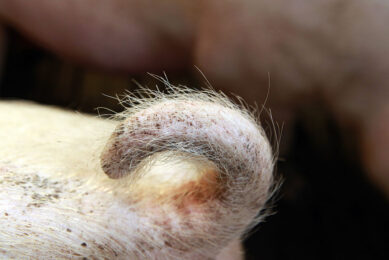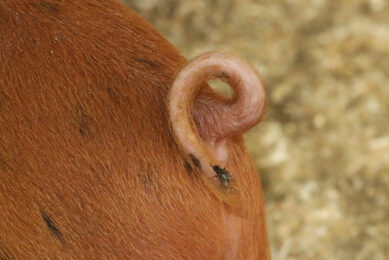Tail biting – more information coming available for its prevention
More information is coming out about the perceived causes of tail biting and ways of controlling it. Can anything prevent it occurring completely though?
More information is coming out about the perceived causes of tail biting and ways of controlling it. Can anything prevent it occurring completely though?
There have been two recent studies looking at tail biting and what British farmers perceived as the main causes and some practical Dutch work showing what might help reduce the incidence.
UK study
In the UK study, farmers were asked what they thought were the possible causal factors of tail biting. The questionnaire was sent out to 429 members of Freedom Foods, a farm assurance scheme that encourages high standards of welfare for its producers.
Approximately, 157 farmers responded, which is a relatively high sample number. Of these 42% did not dock their pigs tails (twice the UK average) but 29% did and a further 29% reported that some of their pig’s tails were docked.
Boredom
Interestingly, boredom was the number one cause, followed by lack of straw, high density stocking and pigs in a bad mood.
In the Dutch study, they looked at preventative measures to reduce the incidence of tail wounding in young pigs. They added chains, rubber hoses, straw in racks (to stop the straw blocking the slatted floor) and the addition of small quantities of straw twice daily (20g/pig/day in total).
Chains and rubber pipes
It showed that chains and rubber pipes were relatively ineffective in reducing tail wounding in young pigs on a pen basis. Straw racks were only moderately effective but small quantities of straw given twice a day were seven times more effective than chains, which are commonly used as a token to the supply of manipulable materials.
The straw is more labour intensive but it gave the pigs something to do and may have reduced boredom, as reported as the main cause in the first study and may have stopped them getting into a ‘bad mood’.
Removing the biter
Once tail biting started, the removal of the biter and the addition of straw both helped reduce the level of tail wounds, but did not eliminate it.
Pig producers will continue to be under pressure to improve the welfare of their animals and stop tail docking and possibly the addition of small quantities of straw on a regular basis may help reduce the problem of tail biting, but nothing at the moment appears to completely eliminate the problem.











